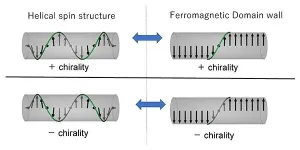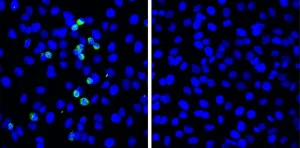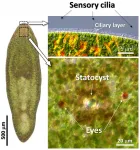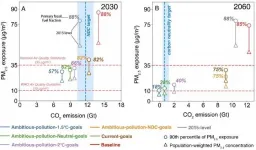(Press-News.org) Scientists of Tomsk Polytechnic University have developed a nanosensor-based hardware and software complex for measurement of cardiac micropotential energies without filtering and averaging-out cardiac cycles in real time. The device allows registering early abnormalities in the function of cardiac muscle cells, which otherwise can be recorded only during open-heart surgery or by inserting an electrode in a cardiac cavity through a vein. Such changes can lead to sudden cardiac death (SCD). Nowadays, there are no alternatives to the Tomsk device for a number of key characteristics in Russia and the world. The research findings of four-year measurement of cardiac micropotential energies using this device and the participation of a volunteer are published in Measurement academic journal (IF: 3,364; Q1).
The heart permanently generates electrical signals. These electrical signals cause cardiac muscle contraction and help the heart to function as a pump. Based on the form and duration of these pulses, it is possible to assess the condition of the heart. The main method of detection of electrical pulses, that is used everywhere, is electrocardiography (ECG). Nevertheless, ECG modern devices detect already critical changes in the function of the myocardium, cardiac muscle.
"Therefore, there is much concern about the creation of devices for early detection of these disorders, when it is still possible to restore cell function using medication and without surgical intervention. To implement this, it is required to record cardiac micropotential energies, electrical pulses emitted by separate cells. Here, there is a question of how to implement it noninvasive. Our research team have worked on this task for a long time, as a consequence, we jointly with the participation of our colleagues, doctors, have developed a hardware and software complex.
The core principles of its operation are similar to ECG, however, we changed sensors: we made nanosensors instead of conventional sensors and managed to measure signals of nanovoltage and microvoltage layers without filtering and averaging-out in broadband. The use of nanosensors led to the necessity to apply original circuit solutions, write individual software.
Ultimately, we gained a tremendous difference in sensitivity," Diana Avdeeva, Head of the TPU Laboratory for Medical Engineering, a research supervisor of the project, says.
The complex consists of a set of sensors, a tiny key device for recording incoming signals from sensors and software for data processing. The sensors are fixed on a human's chest using a conventional conducting gel. The monitoring procedure takes about 20 minutes.
Conventional ECG machines operate on frequencies from 0,05 Hz to 150 Hz, while the device of the Tomsk scientists operates on frequencies to 10,000 Hz.
Silver chloride electrodes are usually used for recording ECG of high quality. Our sensors are also silver chloride electrodes, however, we used silver nanoparticles. There are up to 16 thin plates from porous ceramics in every our sensor, silver nanoparticles are placed in these pores. There are millions of particles in one sensor, where every particle is a silver chloride electrode capable to enhance an electric field of the heart. Silver and gold nanoparticles are capable to enhance an electromagnetic field: visible light by 10,000 folds and infrared radiation by 20 folds. We also refused to use filters for rejection network interference and noises, which are usually used in conventional ECG and significantly distort micropotentials," Diana Avdeeva says.
The published article represents the monitoring data of one volunteer's heart function. He took part in research for four years and was monitored every 7-10 days.
"At the beginning of our research, we recorded clear violations of activity of cardiac muscle cells. His attending physician recommended surgery, he gained an inserted stent at the Cardiology Research Institute. Then, he continued to take part in the research and the device recorded the further gradual restoration of cardiac function," the scientist notes.
Previously, the project received sponsorship of the Technology Platform "Medicine of the Future" and the federal targeted program. The complex was created in partnership with experts of the Cardiology Research Institute of the Tomsk National Research Medical Center of the Russian Academy of Sciences. The industrial partner was the Scientific Production Association Ekran, a Moscow enterprise.
"A task to create a sensitive, tiny and affordable complex was set up, in order in a long run, outpatient clinics and patients at home could use it. Moreover, the developed methods and devices can be used not only in cardiology.
The fields of any electrophysiological research, such as electroencephalography, electromyography and so on are promising. Of course, before applying it to cardiology, we have to pass some essential stages. These are the collection of the required array of statistics, certification of the complex for medical use. All these stages require sponsorship, we are engaged in searching for partners and supporting programs," Mikhail Yuzhakov, Engineer of the TPU Laboratory for Medical Engineering, a participant of the research team, says.
INFORMATION:
Reference:
According to the data of the World Health Organization, cardiovascular diseases are the main cause of death in the world. Among the entire causes of death, a phenomenon of SCD stands out. Most often, SCD is a consequence of myocardial infarction. It is possible to forecast potential dangers to health, tracking the condition of cardiac muscle and the activity of its cells.
Using magnets, a collaborative group have furthered our understanding of chirality.
Their research was published in the journal Physical Review Letters on April 28, 2021.
Chirality is the lack of symmetry in matter. Human hands, for example, express chirality. A mirror image of your right hand differs from your left, giving it two distinguishable chiral states.
Chirality is an important issue in a myriad of scientific fields, ranging from high-energy physics to biology.
Within our bodies, some molecules, such as amino acids, show only one chiral state. In other words, they are homo-chiral. It is crucial to understand how this information is transferred and ...
Type 2 diabetes patients who also have asthma are benefitting from a diabetes medication, typically given to help the pancreas produce more insulin, that also improves asthma symptoms and may reduce lung and airway inflammation.
These types of medication -- GLP-1 receptor agonists -- are a newer class of FDA-approved therapeutics that are generally used in addition to metformin for control of blood sugar or to induce weight loss in patients with obesity.
Researchers from Vanderbilt University Medical Center, Brigham and Women's Hospital, Harvard Medical School and University Hospital Zurich in Switzerland used electronic health record (EHR) data of patients with asthma and type 2 diabetes who initiated treatment with GLP-1R agonists, finding lower rates of asthma exacerbations ...
'Don't forget the mask' - although most people nowadays follow this advice, professionals express different opinions about the effectiveness of face masks. An international team led by researchers from the Max Planck Institute for Chemistry in Mainz, Germany, has now used observational data and model calculations to answer open questions. The study shows under which conditions and in which way masks actually reduce individual and population-average risks of being infected with COVID-19 and help mitigate the corona pandemic. In most environments and situations, ...
PHILADELPHIA--A five-year community outreach and engagement effort by the Abramson Cancer Center at the University of Pennsylvania (ACC) to increase enrollment of Black patients into cancer clinical trials more than doubled the percentage of participants, improving access and treatment for a group with historically low representation in cancer research. The percentage of patients enrolled into a treatment clinical trial, for example, increased from 12 to 24 percent. A significant increase was also observed in non-therapeutic interventional and non-interventional trials.
The findings were published today in an abstract to be presented at the American Society of Clinical Oncology annual meeting on June 5. (Abstract #100). [ADD ...
New York, NY (May 21, 2021) --Women who were highly exposed to ultra-fine particles in air pollution during their pregnancy were more likely to have children who developed asthma, according to a study published in the American Journal of Respiratory and Critical Care Medicine in May. This is the first time asthma has been linked with prenatal exposure to this type of air pollution, which is named for its tiny size and which is not regulated or routinely monitored in the United States.
Slightly more than 18 percent of the children born to these mothers developed asthma in their preschool years, compared ...
Scientists from Hokkaido University have discovered a novel defensive response to SARS-CoV-2 that involves the viral pattern recognition receptor RIG-I. Upregulating expression of this protein could strengthen the immune response in COPD patients.
In the 18 months since the first report of COVID-19 and the spread of the pandemic, there has been a large amount of research into understanding it and developing menas to treat it. COVID-19 does not affect all infected individuals equally. Many individuals are asymptomatic; of those who are symptomatic, the large majority have mild symptoms, and only a small number have severe cases. The reasons for this are not fully understood and are an important area of ongoing research.
A team of scientists ...
The issue of concern was that the Escherichia coli (E. coli) genome, consisting of 4.6 million base pairs of a single circular DNA, is too large to manipulate following the extraction and transfer to other bacteria.
In the present study, a group of Rikkyo University researchers led by Assistant Professor Takahito Mukai and Professor Masayuki Su'etsugu has succeeded in splitting the E.coli genome into tripartite-genome of 1 million base pairs per genome (split-genome) using the smallest E. coli genome strain established so far. In addition, they successfully extracted the split-genome from bacteria and installed it in other E. ...
All living organisms are equipped with sensory organs to detect changes in their surrounding environment. It may not immediately strike us as obvious but, similar to how we can sense heat, cold, light, and darkness, we are also extremely adept at sensing gravity. In our case, it is our inner ear that does this job, helping us maintain balance, posture, and orientation in space. But, what about other organisms, for instance invertebrates that lack a backbone?
The gravity sensing organ in some aquatic invertebrates, known as a "statocyst," is, in fact, rather fascinating. The statocyst is essentially a fluid-filled sac with sensory cells lining its inner wall and a small, mineralized ...
[Highlights]
- Integrated cyber attack analysis platform "NIRVANA Kai" newly supports IPv6 and enhances its functions.
- Observation of IPv6 communications, collection of IPv6-related alerts, and real-time visualization of IPv6 networks.
- Expected to simplify security operations in IPv6 networks.
[Abstract]
The Cybersecurity Laboratory of the National Institute of Information and Communications Technology (NICT, President: TOKUDA Hideyuki, Ph.D.) has enhanced its cyber attack integrated analysis platform "NIRVANA Kai" to support the Internet Protocol version ...
China's clean air policies have substantially reduced PM2.5 air pollution in recent years. Yet >99% of Chinese population is still exposed to PM2.5 concentrations in excess of the World Health Organization (WHO) Air Quality Guidelines of 10 μg/m3. Climate actions targeting to reduce fossil fuel consumption also have substantial air quality benefits. The announcement of ambitious climate commitment to achieve carbon neutrality by 2060 may fuel the power to long-term air quality improvement in China.
Combining Global/China's climate mitigation pathways (i.e. global 2°C- and 1.5°C-pathways, NDC pledges, and carbon neutrality goals) and local clean ...






